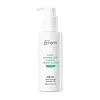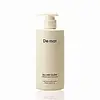What's inside
What's inside
 Key Ingredients
Key Ingredients

 Benefits
Benefits

 Concerns
Concerns

 Ingredients Side-by-side
Ingredients Side-by-side

Water
Skin ConditioningOlea Europaea Fruit Oil
MaskingCarthamus Tinctorius Seed Oil
MaskingIsopentyldiol
HumectantGlycerin
HumectantGlyceryl Stearate
EmollientDecyl Glucoside
CleansingArachidyl Alcohol
Emollient1,2-Hexanediol
Skin ConditioningGlycine Soja Protein
EmulsifyingCynanchum Atratum Extract
Skin ConditioningLimnanthes Alba Seed Oil
Skin ConditioningCeramide NP
Skin ConditioningHydrolyzed Hyaluronic Acid
HumectantSodium Hyaluronate
HumectantPanthenol
Skin ConditioningTocopherol
AntioxidantAllantoin
Skin ConditioningArginine
MaskingEthylhexylglycerin
Skin ConditioningXanthan Gum
EmulsifyingAcrylates/C10-30 Alkyl Acrylate Crosspolymer
Emulsion StabilisingBis-Ethoxydiglycol Succinate
HumectantArachidyl Glucoside
EmulsifyingGlucose
HumectantHydroxyacetophenone
AntioxidantBetaine Salicylate
AntimicrobialCetearyl Alcohol
EmollientBehenyl Alcohol
EmollientCitric Acid
BufferingCitrus Aurantium Bergamia Fruit Oil
MaskingSalvia Sclarea Oil
MaskingWater, Olea Europaea Fruit Oil, Carthamus Tinctorius Seed Oil, Isopentyldiol, Glycerin, Glyceryl Stearate, Decyl Glucoside, Arachidyl Alcohol, 1,2-Hexanediol, Glycine Soja Protein, Cynanchum Atratum Extract, Limnanthes Alba Seed Oil, Ceramide NP, Hydrolyzed Hyaluronic Acid, Sodium Hyaluronate, Panthenol, Tocopherol, Allantoin, Arginine, Ethylhexylglycerin, Xanthan Gum, Acrylates/C10-30 Alkyl Acrylate Crosspolymer, Bis-Ethoxydiglycol Succinate, Arachidyl Glucoside, Glucose, Hydroxyacetophenone, Betaine Salicylate, Cetearyl Alcohol, Behenyl Alcohol, Citric Acid, Citrus Aurantium Bergamia Fruit Oil, Salvia Sclarea Oil
Water
Skin ConditioningHelianthus Annuus Seed Oil
EmollientButylene Glycol
HumectantSimmondsia Chinensis Seed Oil
EmollientDipropylene Glycol
HumectantGlycerin
Humectant1,2-Hexanediol
Skin ConditioningGlyceryl Stearate
EmollientCetearyl Stearate
Skin ConditioningCetearyl Olivate
Sorbitan Olivate
EmulsifyingCeramide NP
Skin ConditioningCentella Asiatica Extract
CleansingPropolis Extract
Skin ConditioningAsiaticoside
AntioxidantMadecassoside
AntioxidantMadecassic Acid
Skin ConditioningAsiatic Acid
Skin ConditioningAllantoin
Skin ConditioningPanthenol
Skin ConditioningPropanediol
SolventArachidyl Alcohol
EmollientDecyl Glucoside
CleansingBehenyl Alcohol
EmollientArachidyl Glucoside
EmulsifyingCarbomer
Emulsion StabilisingCaprylyl Glycol
EmollientArginine
MaskingEthylhexylglycerin
Skin ConditioningAlcohol Denat.
AntimicrobialSodium Carbonate
BufferingCitric Acid
BufferingDipotassium Glycyrrhizate
HumectantWater, Helianthus Annuus Seed Oil, Butylene Glycol, Simmondsia Chinensis Seed Oil, Dipropylene Glycol, Glycerin, 1,2-Hexanediol, Glyceryl Stearate, Cetearyl Stearate, Cetearyl Olivate, Sorbitan Olivate, Ceramide NP, Centella Asiatica Extract, Propolis Extract, Asiaticoside, Madecassoside, Madecassic Acid, Asiatic Acid, Allantoin, Panthenol, Propanediol, Arachidyl Alcohol, Decyl Glucoside, Behenyl Alcohol, Arachidyl Glucoside, Carbomer, Caprylyl Glycol, Arginine, Ethylhexylglycerin, Alcohol Denat., Sodium Carbonate, Citric Acid, Dipotassium Glycyrrhizate
 Reviews
Reviews

Ingredients Explained
These ingredients are found in both products.
Ingredients higher up in an ingredient list are typically present in a larger amount.
1,2-Hexanediol is a synthetic liquid and another multi-functional powerhouse.
It is a:
- Humectant, drawing moisture into the skin
- Emollient, helping to soften skin
- Solvent, dispersing and stabilizing formulas
- Preservative booster, enhancing the antimicrobial activity of other preservatives
Allantoin is a soothing ingredient known for its protective and moisturizingg properties. Because of this, it is often added to products with strong active ingredients.
Studies show higher concentrations of this ingredient can promote wound healing.
Though it can be derived from the comfrey plant, allantoin is produced synthetically for cosmetic products to ensure purity.
Learn more about AllantoinArachidyl Alcohol is a fatty alcohol made from peanut oil. It is an emollient, emulsifier, and thickener.
You'll most likely find this ingredient as an emulsifier in water-based cosmetics.
We don't have a description for Arachidyl Glucoside yet.
Arginine is an amino acid that is important for human development. Your body uses is it to produce hair keratin and skin collagen.
As a cosmetic ingredient, Arginine has antioxidant properties and can also help repair damaged skin. This ingredient is derived either synthetically or from animals.
Arginine isn't fungal acne safe when used in the presence of other lipids (fats, fatty acids, oils, esters, etc). Oils and fats occur naturally within the skin, so take caution when using Arginine if you're prone to fungal acne.
Learn more about ArginineBehenyl Alcohol is a type of fatty alcohol (these are different from the drying, solvent alcohols).
Fatty Alcohols have hydrating properties and are most often used as an emollient or to thicken a product. They are usually derived from natural fats and oils; behenyl alcohol is derived from the fats of vegetable oils.
Emollients help keep your skin soft and hydrated by creating a film that traps moisture in.
In 2000, Behenyl Alcohol was approved by the US as medicine to reduce the duration of cold sores.
Learn more about Behenyl AlcoholCeramide NP is a type of ceramide and formally known as ceramide 3.
Ceramides are intercellular lipids naturally found in our skin that bonds dead skin cells together to create a barrier. They are known for their ability to hold water and thus are a great ingredient for dry skin.
Ceramides are an important building block for our skin barrier. A stronger barrier helps the skin look more firm and hydrated. By bolstering the skin ceramides act as a barrier against irritating ingredients. This can help with inflammation as well.
If you would like to eat ceramides, sweet potatoes contain a small amount.
Read more about other common types of ceramides here:
Ceramide AP
Ceramide EOP
Citric Acid is an alpha hydroxy acid (AHA) naturally found in citrus fruits like oranges, lemons, and limes.
Like other AHAs, citric acid can exfoliate skin by breaking down the bonds that hold dead skin cells together. This helps reveal smoother and brighter skin underneath.
However, this exfoliating effect only happens at high concentrations (20%) which can be hard to find in cosmetic products.
Due to this, citric acid is usually included in small amounts as a pH adjuster. This helps keep products slightly more acidic and compatible with skin's natural pH.
In skincare formulas, citric acid can:
While it can provide some skin benefits, research shows lactic acid and glycolic acid are generally more effective and less irritating exfoliants.
Most citric acid used in skincare today is made by fermenting sugars (usually from molasses). This synthetic version is identical to the natural citrus form but easier to stabilize and use in formulations.
Read more about some other popular AHA's here:
Learn more about Citric AcidDecyl Glucoside is a glucose-based surfactant and emulsion stabilizer. It is created by reacting glucose with the fatty acids from plants.
Surfactants help clean the skin by trapping oil, sebum, and dirt to be washed away. As an emulsion stabilizer, it stabilizes the ingredients in a product by preventing them from separating.
This ingredient is biodegradable and non-toxic. This ingredient is commonly found in baby shampoos.
Decyl Glucoside is sometimes used to stabilize the UV filter Tinosorb.
Learn more about Decyl GlucosideEthylhexylglycerin (we can't pronounce this either) is commonly used as a preservative and skin softener. It is derived from glyceryl.
You might see Ethylhexylglycerin often paired with other preservatives such as phenoxyethanol. Ethylhexylglycerin has been found to increase the effectiveness of these other preservatives.
Glycerin is already naturally found in your skin. It helps moisturize and protect your skin.
A study from 2016 found glycerin to be more effective as a humectant than AHAs and hyaluronic acid.
As a humectant, it helps the skin stay hydrated by pulling moisture to your skin. The low molecular weight of glycerin allows it to pull moisture into the deeper layers of your skin.
Hydrated skin improves your skin barrier; Your skin barrier helps protect against irritants and bacteria.
Glycerin has also been found to have antimicrobial and antiviral properties. Due to these properties, glycerin is often used in wound and burn treatments.
In cosmetics, glycerin is usually derived from plants such as soybean or palm. However, it can also be sourced from animals, such as tallow or animal fat.
This ingredient is organic, colorless, odorless, and non-toxic.
Glycerin is the name for this ingredient in American English. British English uses Glycerol/Glycerine.
Learn more about GlycerinGlyceryl Stearate is a mix of glycerin and stearic acid.
It is used to stabilize the mixing of water and oil ingredients. By preventing these ingredients from separating, it can help elongate shelf life. It can also help thicken the product's texture.
As an emollient, it helps soften skin and supports barrier-replenishing ingredients.
In cosmetics, Glyceryl Stearate is often made from vegetable oils or synthetically produced.
This ingredient may not be fungal-acne safe
Fun fact: The human body also creates Glyceryl Stearate naturally.
Learn more about Glyceryl StearatePanthenol is a common ingredient that helps hydrate and soothe the skin. It is found naturally in our skin and hair.
There are two forms of panthenol: D and L.
D-panthenol is also known as dexpanthenol. Most cosmetics use dexpanthenol or a mixture of D and L-panthenol.
Panthenol is famous due to its ability to go deeper into the skin's layers. Using this ingredient has numerous pros (and no cons):
Like hyaluronic acid, panthenol is a humectant. Humectants are able to bind and hold large amounts of water to keep skin hydrated.
This ingredient works well for wound healing. It works by increasing tissue in the wound and helps close open wounds.
Once oxidized, panthenol converts to pantothenic acid. Panthothenic acid is found in all living cells.
This ingredient is also referred to as pro-vitamin B5.
Learn more about PanthenolWater. It's the most common cosmetic ingredient of all. You'll usually see it at the top of ingredient lists, meaning that it makes up the largest part of the product.
So why is it so popular? Water most often acts as a solvent - this means that it helps dissolve other ingredients into the formulation.
You'll also recognize water as that liquid we all need to stay alive. If you see this, drink a glass of water. Stay hydrated!
Learn more about Water